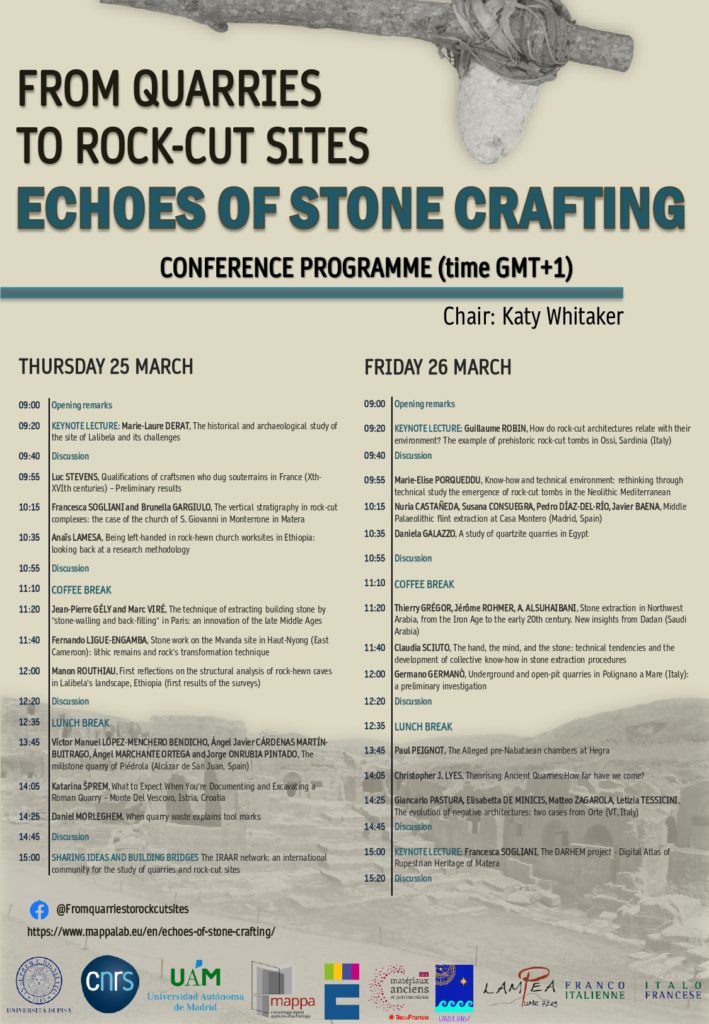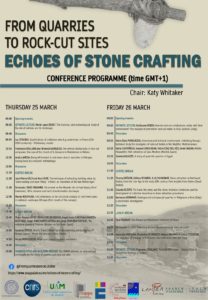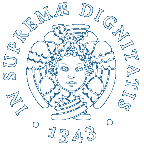
 Il 25 e 26 marzo 2021 si svolgerà la conferenza internazionale “From quarries to rock-cut sites. Echoes of stone crafting“, organizzata dal Laboratorio Mappa tra le attività del Dipartimento di Eccellenza, in collaborazione con l’Università di Pisa, il CNRS di Parigi e l’Università Autonoma di Madrid.
Il 25 e 26 marzo 2021 si svolgerà la conferenza internazionale “From quarries to rock-cut sites. Echoes of stone crafting“, organizzata dal Laboratorio Mappa tra le attività del Dipartimento di Eccellenza, in collaborazione con l’Università di Pisa, il CNRS di Parigi e l’Università Autonoma di Madrid.
La conferenza si terrà online in lingua inglese e potrà essere seguita in diretta streaming sul canale YouTube MediaEventi Unipi e sulla pagina facebook Media Events.
Per tutte le informazioni sulla conferenza, visitare la pagina dedicata: www.mappalab.eu/en/echoes-of-stone-crafting
Link per seguire la conferenza
25 mattino
https://www.youtube.com/watch?v=_Y4z0_S-RSc
25 pomeriggio
https://www.youtube.com/watch?v=4tkPf7OBgms
26 mattino
https://www.youtube.com/watch?v=YAXJyZdg1Kw
26 pomeriggio
https://www.youtube.com/watch?v=XfCQv2Y9BIs
Programma
Giovedì 25 marzo
09:00 – Opening remarks
09:20 – KEYNOTE LECTURE: MARIE-LAURE DERAT, The historical and archaeological study of the site of Lalibela and its challenges
09:40 – Discussion
09:55 – LUC STEVENS, Qualifications of craftsmen who dug souterrains in France (Xth-XVIth centuries) – Preliminary results
10:15 – FRANCESCA SOGLIANI AND BRUNELLA GARGIULO, The vertical stratigraphy in rock-cut complexes: the case of the church of S. Giovanni in Monterrone in Matera
10:35 – ANAÏS LAMESA, Being left-handed in rock-hewn church worksites in Ethiopia: looking back at a research methodology
10:55 – Discussion
11:10 – COFFEE BREAK
11:20 – JEAN-PIERRE GÉLY AND MARC VIRÉ, The technique of extracting building stone by “stone-walling and back-filling” in Paris: an innovation of the late Middle Ages
11:40 – FERNANDO LIGUE-ENGAMBA, Stone work on the Mvanda site in Haut-Nyong (East Cameroon): lithic remains and rock’s transformation technique
12:00 – MANON ROUTHIAU, First reflections on the structural analysis of rock-hewn caves in Lalibela’s landscape, Ethiopia (first results of the surveys)
12:20 – Discussion
12:35 – LUNCH BREAK
13:45 – VÍCTOR MANUEL LÓPEZ-MENCHERO BENDICHO, ÁNGEL JAVIER CÁRDENAS MARTÍN-BUITRAGO, ÁNGEL MARCHANTE ORTEGA AND JORGE ONRUBIA PINTADO, The millstone quarry of Piédrola (Alcázar de San Juan, Spain)
14:05 – KATARINA ŠPREM, What to Expect When You’re Documenting and Excavating a Roman Quarry – Monte Del Vescovo, Istria, Croatia
14:25 – DANIEL MORLEGHEM, When quarry waste explains tool marks
14:45 – Discussion
15:00 – SHARING IDEAS AND BUILDING BRIDGES, The IRAAR network: an international community for the study of quarries and rock-cut sites
***
Venerdì 26 marzo
09:00 – Opening remarks
09:20 – KEYNOTE LECTURE: GUILLAUME ROBIN, How do rock-cut architectures relate with their environment? The example of prehistoric rock-cut tombs in Ossi, Sardinia (Italy)
09:40 – Discussion
09:55 – MARIE-ELISE PORQUEDDU, Know-how and technical environment: rethinking through technical study the emergence of rock-cut tombs in the Neolithic Mediterranean
10:15 – NURIA CASTAÑEDA, SUSANA CONSUEGRA, PEDRO DÍAZ-DEL-RÍO, JAVIER BAENA, Middle Palaeolithic flint extraction at Casa Montero (Madrid, Spain)
10:35 – DANIELA GALAZZO, A study of quartzite quarries in Egypt
10:55 – Discussion
11:10 – COFFEE BREAK
11:20 – THIERRY GRÉGOR, JÉRÔME ROHMER, A. ALSUHAIBANI, Stone extraction in Northwest Arabia, from the Iron Age to the early 20th century. New insights from Dadan (Saudi Arabia)
11:40 – CLAUDIA SCIUTO, The hand, the mind, and the stone: technical tendencies and the development of collective know-how in stone extraction procedures
12:00 – GERMANO GERMANÒ, Underground and open-pit quarries in Polignano a Mare (Italy): a preliminary investigation
12:20 – Discussion
12:35 – LUNCH BREAK
13:45 – PAUL PEIGNOT, The Alleged pre-Nabataean chambers at Hegra
14:05 – CHRISTOPHER J. LYES, Theorising Ancient Quarries:How far have we come?
14:25 – GIANCARLO PASTURA, ELISABETTA DE MINICIS, MATTEO ZAGAROLA, LETIZIA TESSICINI, The evolution of negative architectures: two cases from Orte (VT, Italy)
14:45 – Discussion
15:00 – KEYNOTE LECTURE: FRANCESCA SOGLIANI, The DARHEM project – Digital Atlas of Rupestrian Heritage of Matera
15:20 – Discussion
***
Giovedì 25 marzo
09:00 – Opening remarks
09:20 – KEYNOTE LECTURE: MARIE-LAURE DERAT, The historical and archaeological study of the site of Lalibela and its challenges
09:40 – Discussion
09:55 – LUC STEVENS, Qualifications of craftsmen who dug souterrains in France (Xth-XVIth centuries) – Preliminary results
10:15 – FRANCESCA SOGLIANI AND BRUNELLA GARGIULO, The vertical stratigraphy in rock-cut complexes: the case of the church of S. Giovanni in Monterrone in Matera
10:35 – ANAÏS LAMESA, Being left-handed in rock-hewn church worksites in Ethiopia: looking back at a research methodology
10:55 – Discussion
11:10 – COFFEE BREAK
11:20 – JEAN-PIERRE GÉLY AND MARC VIRÉ, The technique of extracting building stone by “stone-walling and back-filling” in Paris: an innovation of the late Middle Ages
11:40 – FERNANDO LIGUE-ENGAMBA, Stone work on the Mvanda site in Haut-Nyong (East Cameroon): lithic remains and rock’s transformation technique
12:00 – MANON ROUTHIAU, First reflections on the structural analysis of rock-hewn caves in Lalibela’s landscape, Ethiopia (first results of the surveys)
12:20 – Discussion
12:35 – LUNCH BREAK
13:45 – VÍCTOR MANUEL LÓPEZ-MENCHERO BENDICHO, ÁNGEL JAVIER CÁRDENAS MARTÍN-BUITRAGO, ÁNGEL MARCHANTE ORTEGA AND JORGE ONRUBIA PINTADO, The millstone quarry of Piédrola (Alcázar de San Juan, Spain)
14:05 – KATARINA ŠPREM, What to Expect When You’re Documenting and Excavating a Roman Quarry – Monte Del Vescovo, Istria, Croatia
14:25 – DANIEL MORLEGHEM, When quarry waste explains tool marks
14:45 – Discussion
15:00 – SHARING IDEAS AND BUILDING BRIDGES, The IRAAR network: an international community for the study of quarries and rock-cut sites
***
Venerdì 26 marzo
09:00 – Opening remarks
09:20 – KEYNOTE LECTURE: GUILLAUME ROBIN, How do rock-cut architectures relate with their environment? The example of prehistoric rock-cut tombs in Ossi, Sardinia (Italy)
09:40 – Discussion
09:55 – MARIE-ELISE PORQUEDDU, Know-how and technical environment: rethinking through technical study the emergence of rock-cut tombs in the Neolithic Mediterranean
10:15 – NURIA CASTAÑEDA, SUSANA CONSUEGRA, PEDRO DÍAZ-DEL-RÍO, JAVIER BAENA, Middle Palaeolithic flint extraction at Casa Montero (Madrid, Spain)
10:35 – DANIELA GALAZZO, A study of quartzite quarries in Egypt
10:55 – Discussion
11:10 – COFFEE BREAK
11:20 – THIERRY GRÉGOR, JÉRÔME ROHMER, A. ALSUHAIBANI, Stone extraction in Northwest Arabia, from the Iron Age to the early 20th century. New insights from Dadan (Saudi Arabia)
11:40 – CLAUDIA SCIUTO, The hand, the mind, and the stone: technical tendencies and the development of collective know-how in stone extraction procedures
12:00 – GERMANO GERMANÒ, Underground and open-pit quarries in Polignano a Mare (Italy): a preliminary investigation
12:20 – Discussion
12:35 – LUNCH BREAK
13:45 – PAUL PEIGNOT, The Alleged pre-Nabataean chambers at Hegra
14:05 – CHRISTOPHER J. LYES, Theorising Ancient Quarries:How far have we come?
14:25 – GIANCARLO PASTURA, ELISABETTA DE MINICIS, MATTEO ZAGAROLA, LETIZIA TESSICINI, The evolution of negative architectures: two cases from Orte (VT, Italy)
14:45 – Discussion
15:00 – KEYNOTE LECTURE: FRANCESCA SOGLIANI, The DARHEM project – Digital Atlas of Rupestrian Heritage of Matera
15:20 – Discussion
***


